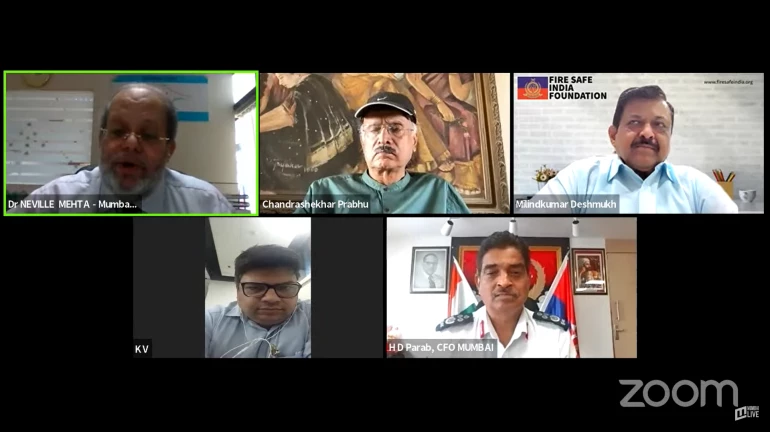
Every year, National Fire Services Week is observed from April 14-20 to pay tribute to the 71 firefighters who sacrificed their lives fighting the massive fire at Mumbai dockyard on April 14, 1944.
However, decades into this, Mumbai’s fire risk has not been curtailed. According to reports, in the past five years, the city has seen over 26,000 fire occurrences which have only brought to light the vulnerabilities.
Therefore, to discuss these risks, Mumbai First organized a panel discussion that included notable personalities such as Hemant Parab, Chief Fire Officer, Mumbai Fire Brigade (MFB), M.V Deshmukh, Fire Officer, Chandrashekhar Prabhu, youngest MLA to the Maharashtra Legislative Assembly (1985) and Ketan Vaidya, Journalist.
The invigorating discussion commenced with Prabhu encompassing firefighting into primary facets that entail; policy of urban development, the development plan of the city and development control regulation. Deshmukh, however, further boiled it down to prevention and protection of fire.
Deshmukh condenses towards Mumbai by elaborating on how the development control rules are not adequate for safe building. He claims that Mumbai has a 50 per cent deficiency in its fire brigade capacity with it being arduous to find land for fire brigades. Similarly, with drones sweeping everyone off their feet, Deshmukh opines that it is only a secondary aspect and that primary importance should be accorded to alarms and sprinklers.
To this, the MFB Chief Fire Officer responded that now, sprinklers are given everywhere which is supported through refresher training, fire stations, mini fire stations and firefighting bikes.
The discussion also identified the challenges faced by the MFB as Mumbai goes through rapid infrastructure that entailed communication issues in the underground metro and the coastal road. Parab declared that the authority has been visiting these locations to comprehend the issue as well as seek solutions.
Further, Vaidya shares his two cents on the fire safety condition of Mumbai by uttering that the larger city planning does not align with fire security. Other misgivings he believes are narrow lanes, a large number of redevelopment projects and metro obstructions.
He recommends that city responders be trained and the citizens be involved. To this, Parab added that with the Agni Rakshak project already in place which is a fire safety citizen training program, more people should be partaking in the same.
One panel member recommended that the COVID-19 war ward rooms could be utilized by the fire brigades. While another sought alteration in the development plan for holistic changes.
Later in the discussion, a question was posed before the panel that sought reasons for irregularities in regular safety audits. Parab explained that since auditing is a continuous process, numbers don’t immediately add up. He said that buildings are given 120 days to comply with norms as per regulations, after which action is taken.
Parab stated that now with an inspection software prepared, an officer will register data on it, therefore, all inspections recorded from April 14 onwards will be registered. Additionally, 10 per cent of the Form B which is given every six months will be checked by the officer so if faults are found penalties will be issued.
The conversation later shifted gears with the media’s role in strengthening Mumbai’s fire safety mechanism being questioned. Vaidya responded to this by highlighting that until now reportage has been focused on mere reaction.
This, however, should be altered with a sustained campaign. He then recommends that the MFB could be compiled into three wings namely, training, enforcement and firefighting.
The next question posed before the panel concerned itself with Mumbai’s 200 skyscrapers and what are the key fire equipment for its safety. Parab unearths that presently the 90-meter ladder with the MFB goes up to only the 30th floor. Therefore, such buildings are given instruments to fight fire at higher levels, the buildings, thus, only have to maintain it.
Prabhu affixed to this saying that those residing above the 30th floor should be aware of their own fire safety. An ingenious suggestion was also made to utilize social media to inculcate fire training.
Repositioning to look at the bigger picture, the panel was asked about its views on the shortcomings of the Maharashtra Fire Prevention and Life Safety Measures Act, 2006. Deshmukh observes that while the focus is on high rises, the number of fires and causalities are more in low-rise buildings which continue to stay out of focus.
He believes that there shouldn’t be any disparities between life, measures to address this such as fire-resistant stairs should be introduced.
Nearing the end of the talk, Vaidya pronounces that one needs to look at these fire issues holistically. With a focus on awareness, prominence should be accorded to urban planning, citizen involvement and dynamic awareness planning.
Deshmukh appends to this by accentuating the coming together of eminent personalities and technology. Apart from reviewing the law, he believes that volunteers should also be made aware of what to do.
Also Read: Fire Safety Gone For A Toss In Mumbai? How BMC Can Better Address This Pertinent Issue





